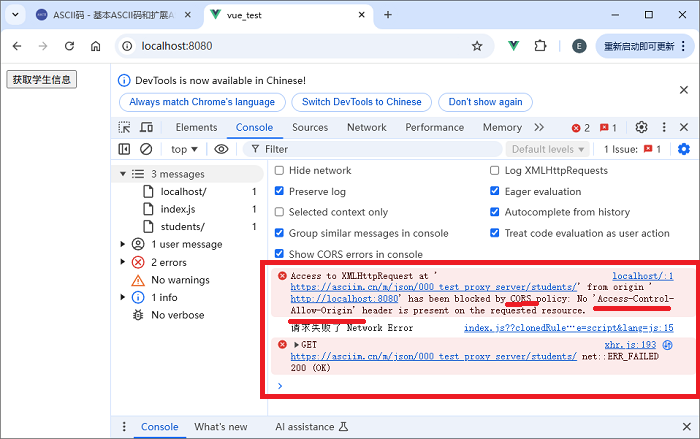笔记
ajax方式
常用的发送 ajax 方式有哪些?
1. xhr //不常用这种直接操作
xhr 是 new XMLHttpRequest() 的对象。
两个常用的api:
- xhr.open() 配置请求信息
- xhr.send() 发出一个请求
在实际工程中,不常 new XHLHttpRequest() ,可能是闲麻烦。
常用的是对 xhr 的 二次封装。E.g jQuery axios
2. jQuery
标准发音:/‘dʒeɪkjuːri/或 /‘dʒeɪkwɪri/
例如:
$.get
$.post
该库核心:封装DOM操作(80%),其它操作(20%)。
3.axios //在用 √
axios 音标:/æksiːəʊs/
特点:
是 jQuery 体积的 1/4
安装 axios
npm i axios安装过程:
> npm i axios
added 8 packages in 3s
120 packages are looking for funding
run `npm fund` for details4.fetch
fetch 和 xhr 属于平级。
在Window就有 fetch方法,可以直接使用。
兼容性差(例如:在IE上无法使用)
跨域

如上图所示,就属于 跨域问题。
同源策略: 就是三个一致
- 协议名
- 主机名
- 端口号
例如: http://localhost:8080
那么协议名为 http , 主机名为 localhost 端口为 8080
解决跨域的三种方法:
CROS
CROS解决跨域,才是真正意义上的跨域。
因为 浏览器 如果通过 CROS请求 服务器,那么服务器在响应回传数据的时候,添加了特殊的响应头,浏览器一看见这些响应头就知道:虽然你跨域了,但是服务器已经表态了,这个数据要给你,那么浏览器就会一抬手把数据给你了。jsonp
jsonp 是一种巧妙地借助 script标签中的src属性在引入外部资源的时候,不受同源策略限制的这一特点办到的。
这种方式,需要前端和后端人员一起努力才行。
这种方式,只能解决get问题,不能解决post问题,所以比较鸡肋。配置一个代理服务器
为了方便操作,我们用 Vue CLI 脚手架配置一个代理服务器。
这种方法,只能配置一个代理,不能配置多个。
根据教程,我没有找到对应的 test_proxy_server.zip 压缩包,所以我根据视频内容模拟了相关的数据,大家可以直接访问:
- 学生
https://asciim.cn/m/json/000_test_proxy_server/students.json
返回内容:[ { "id": "001", "name": "tom", "age": 18 }, { "id": "002", "name": "jerry", "age": 19 }, { "id": "003", "name": "tony", "age": 120 } ] - 车
https://asciim.cn/m/json/000_test_proxy_server/cars.json
返回内容:[ { "id": "001", "name": "奔驰", "price": 199 }, { "id": "002", "name": "马自达", "price": 109 }, { "id": "003", "name": "捷达", "price": 120 } ]
重要源码
App.vue
<template>
<div>
<button @click="getStudents">获取学生信息</button>
</div>
</template>
<script>
//引入 axios
import axios from 'axios'
export default {
name:'App',
methods:{
getStudents(){
//axios.get('https://asciim.cn/m/json/000_test_proxy_server/students/').then( //给2个回调:成功回调+失败回调
//通过 代理服务器 拿数据:
axios.get('http://localhost:8080/m/json/000_test_proxy_server/students/').then( //给2个回调:成功回调+失败回调
response => { //如果成功了,就输出
console.log('请求成功了',response.data)
},
error => {
console.log('请求失败了',error.message)
}
)
}
}
}
</script>vue.config.js
//如何使用,参考官网 https://cli.vuejs.org/zh/config/
//该文件最终输送给 webpack(基于 Node.js, 而Node.js采用的是 CommonJS)
const { defineConfig } = require('@vue/cli-service')
//暴露方式: CommonJS
module.exports = defineConfig({
transpileDependencies: true,
pages:{
index:{
//入口
entry:'src/main.js',
},
},
lintOnSave:false, //关闭语法检查
//开启代理服务器
devServer:{
//proxy: 'http://localhost:5000'
//注意:只能配置一个代理
proxy: 'https://asciim.cn/'
}
})vue.config.js
//如何使用,参考官网 https://cli.vuejs.org/zh/config/
//该文件最终输送给 webpack(基于 Node.js, 而Node.js采用的是 CommonJS)
const { defineConfig } = require('@vue/cli-service')
//暴露方式: CommonJS
module.exports = defineConfig({
transpileDependencies: true,
pages:{
index:{
//入口
entry:'src/main.js',
},
},
lintOnSave:false, //关闭语法检查
//开启代理服务器
devServer:{
//proxy: 'http://localhost:5000'
//注意:只能配置一个代理
proxy: 'https://asciim.cn/'
}
})